What is chicken broth?

First and foremost, chicken broth is a type of broth. So, what is broth? Broth is also known as bouillon and is made from meat, vegetables or bones simmered in water. After simmering for a couple hours or so, the meat, bones or vegetables are removed and the resulting flavor-infused liquid is known as broth. As you’d imagine, chicken broth is typically made from water in which chicken (and usually some vegetables) has been simmered.
While this is the traditional way that broth is made, one can also add bouillon cubes to water to create a similar result. Bouillon cubes are usually made from dehydrated ingredients, stock, seasoning and fat, leading to a concentrated flavor that matches that of traditional broth when added to water.
What is the difference between broth, bouillon and stock?
Let’s start with the easy part. Broth and bouillon are widely accepted as being different terms for the same thing. However, the story is a little more complicated with stock. Many people, including professional chefs, use the terms “broth” and “stock” interchangeably, meaning both are used to refer to the same thing. But many also draw a line between broth and stock. Broth is sometimes regarded as being more flavorful but not quite as rich as stock. This is because stock is usually simmered for longer periods of time than broth and uses bones rather than meat as its primary ingredient. The simmering of bones produces a richer, creamier liquid higher in collagen but not as flavorsome as broth. Stock is also often seen as being more versatile than broth, as it is less distinctive in flavor by this definition. Broth is generally lower in calories than stock.
How healthy (or unhealthy) is it?
Healthwise, chicken broth has its upsides and downsides. But first, let’s start with the elephant in the room: chicken broth powder (and many other forms) has staggering salt content, with almost 1,000% of your daily recommended intake per 100g of dry broth. But before you go chucking out your broth supply, keep in mind that this number will be much lower if you’re only adding a small amount to water to use in your recipes. Still, broth is infamous for its high salt content and it can sometimes be challenging to find a variety that doesn’t go over your daily recommended intake in just 1 or 2 servings. Consuming too much salt comes with several serious health risks, including increased chances of hypertension, high blood pressure, heart disease and strokes. Chicken broth also contains moderate amounts of total fat and saturated fat, but this is nothing to worry about as long as it is consumed in moderation.
On the plus side, chicken broth contains a good amount of protein (17g per 100g) and moderate amounts of several vitamins and minerals, such as calcium, potassium, magnesium and vitamin B-6. Chicken broth also won’t use up too many of your daily calories, especially if you’re only using a tablespoon or 2.
Overall, the main health concern with chicken broth is its high salt content. However, low-salt varieties are available. Other than that, chicken broth contains a good amount of protein and some vitamins and minerals without too many health drawbacks, making it a reasonably healthy food if consumed in moderation.
Nutritional Breakdown:
Chicken broth (dry) |
Amount (per 100 g) |
% Recommended daily intake |
Calories |
267 kcal |
14 % |
Total fat |
14 g |
21 % |
Saturated fat |
3.4 g |
17 % |
Cholesterol |
13 mg |
4 % |
Salt |
23,875 mg |
994 % |
Protein |
17 g |
34 % |
Total carbohydrates |
18 g |
6 % |
Calcium |
187 mg |
18 % |
Iron |
1.03 mg |
5 % |
Potassium |
309 mg |
8 % |
Magnesium |
56 mg |
14 % |
Vitamin B-6 |
0.1 mg |
5 % |
(Based on nutritional information from USDA on chicken broth.)
What recipes are chicken broth used in?
Chicken broth is often used to add flavor to soups, sauces, gravies, stews, stuffing and more. However, it is a versatile ingredient and has the potential to be used in a variety of other dishes.
Why do we need chicken broth substitutes?
As we mentioned above, chicken broth, especially the powdered varieties, often contain very high amounts of salt, leading many to look for healthier, less salty alternatives.
Chicken broth obviously isn’t on the menu for vegans, as it contains chicken and sometimes other non-vegan ingredients too. If you’re cutting out the meat, it’s great to have a back-up plan for when a recipe calls for chicken or other meat-based broths.
Sometimes we simply aren’t prepared to see chicken broth crop up in a recipe we were all set to make. Do we really have to traipse all the way to the store for this one missing ingredient? Nope! This article was created with each of these needs in mind and has a perfect substitute for any occasion. So without further ado, let’s find the perfect option for you.
Note:
🌱 = vegan
🥩 = non-vegan
🥩 / 🌱 = non-vegan and vegan options
* Always check the label and/or product information for dietary information.1. Make your own (chicken or vegetable broth) 🥩 / 🌱
Best for: any chicken broth dish
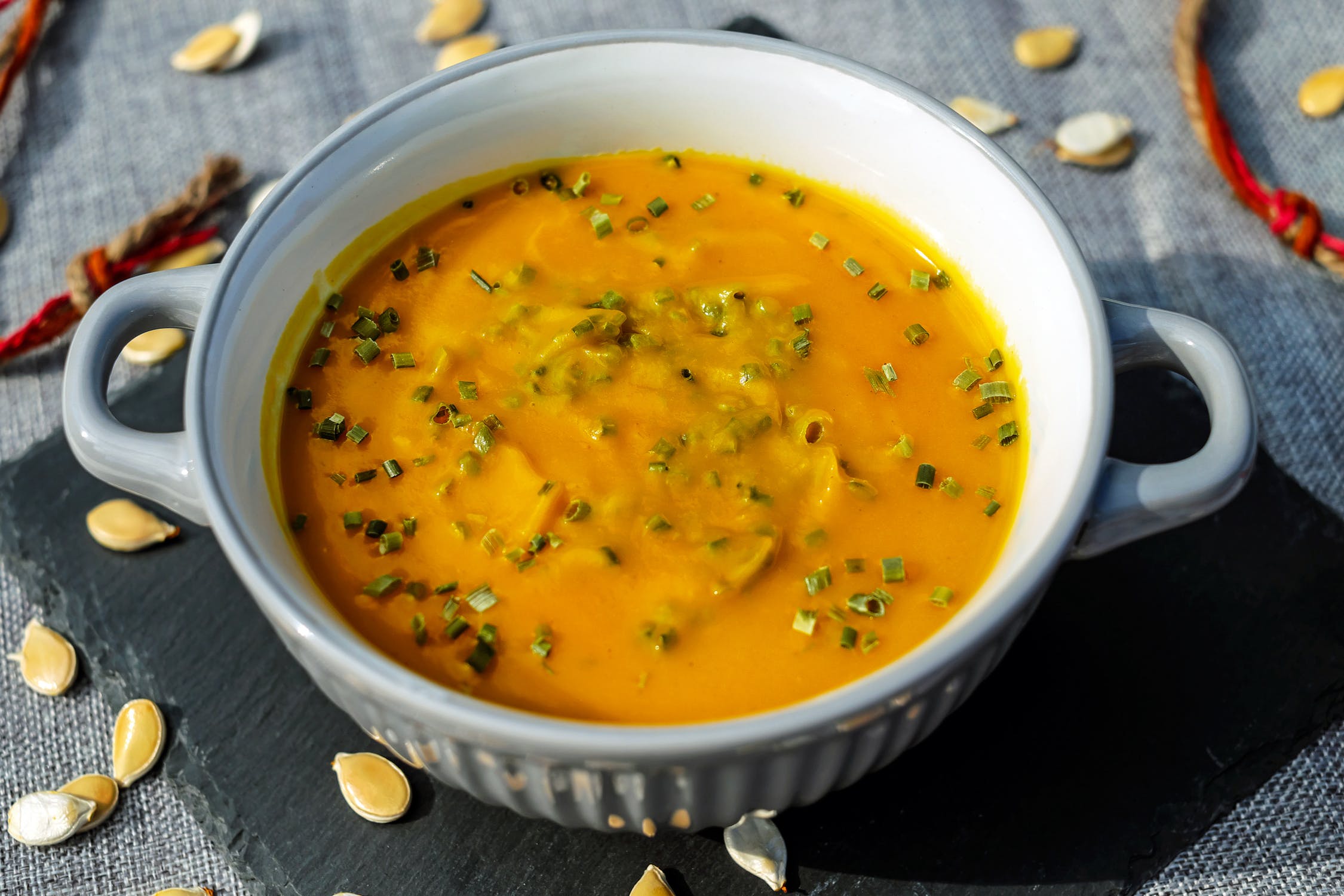
Overview:
Want a great-tasting, customizable broth that won’t overload your body with salt? Then why not make your own. Homemade broth takes a little extra time and energy to create, but it’s totally worth the effort if you have the time to spare.
Advantages:
Aside from tasting just as good or even better than store-bought broth, our favorite thing about making your own broth is that your options are really unlimited here. Want a classic chicken broth with an extra hint of all your favorite veggies? No problem. Want a flavorsome vegan alternative without being restricted by what’s sold on the market? Can do! There are numerous recipes online for both traditional chicken broths and veggie-based vegan broths, and you can always improvise to suit your own individual taste.
With the inherent flexibility of this option also comes the ability to control just how healthy (or unhealthy) your broth will be. This is a great way to avoid the ridiculously high salt contents of many store-bought options without losing out on the flavor. You can also add as many healthy veggies as you like to soak up some extra vitamins and minerals.
While it does take a while to make a batch of stock, once you’ve made it, you can either freeze the leftover portions or keep them in the fridge for up to 5 days. It still doesn’t make it the most convenient option in the world, but it’s nice to have a few great-tasting leftover portions for future use.
Because you can use whatever ingredients you like for this substitute, it makes a great option for vegans and meat-eaters alike.
Disadvantages:
The main drawback of this option is the time and effort it takes. It can take some time to get all your ingredients together, plus a couple hours of simmering the mixture and finally storing the leftovers. Homemade broth isn’t as convenient or time-friendly as the premade stuff, but what it lacks in convenience it certainly makes up for in flavor and versatility.
Nutritional breakdown:
The nutrition values of this option can vary widely depending on which recipe you go for. However, most homemade broths will contain much less salt than premade options.2. Beef broth 🥩
Best for: most chicken broth dishes
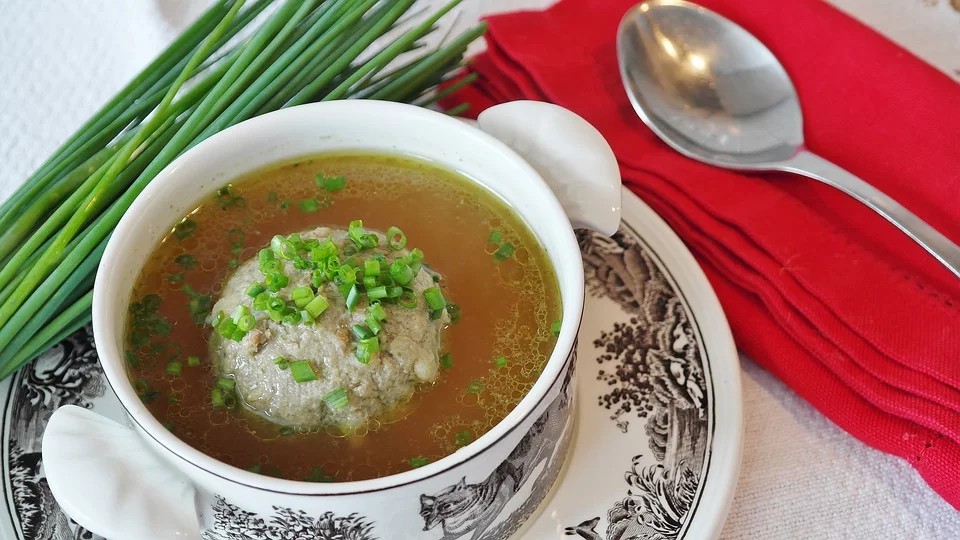
Overview:
If you’re all out of chicken broth but have beef broth to spare, this could be a good option for you. Beef broth is obviously not vegan friendly and has a different flavor to chicken broth, but if you don’t mind a more beef-flavored end result, it makes a great substitute all the same.
Advantages:
Although there is a notable difference in flavor between chicken and beef broth, this option will still provide that same rich, meaty flavor as chicken broth. There aren’t really any good reasons to go out and buy beef broth instead of chicken broth, but if you already have it in your cupboard and enjoy the flavor, you might as well go ahead and sub it in.
Beef broth has very similar nutritional values to chicken broth, which is both a blessing and a curse, but let’s start with the blessings. Like chicken broth, beef broth has a high protein content and moderate amounts of vitamins and minerals such as calcium, potassium and magnesium. It is also not too high on calories, with around 238kcal per 100g of powder (much less per serving if you’re just using a tablespoon or 2).
Disadvantages:
But on the downside of its similarity to chicken broth, beef broth is also typically very high in salt. If you go for a powdered version, you could be looking at over 700% of your daily recommended salt intake per 100g. This will be significantly less if you’re just adding a bit to water or using a low-salt version, but it’s worth keeping an eye on if you’re health conscious.
Another obvious disadvantage of this option is that it’s neither vegetarian nor vegan, as it is made from liquid in which beef has been simmered. You may be able to find some beef-flavored vegan options on the market, but if you’re going out of your way to look for a meat-flavored vegan option, you may as well go for a vegan chicken-flavored broth to get a closer flavor match.
Nutritional breakdown:
Beef broth (dry) |
Amount (per 100 g) |
% Recommended daily intake |
Calories |
238 kcal |
12 % |
Total fat |
9 g |
14 % |
Saturated fat |
4.3 g |
22 % |
Cholesterol |
10 mg |
3 % |
Salt |
16,981 mg |
708 % |
Protein |
16 g |
32 % |
Total carbohydrates |
23.7 g |
8 % |
Calcium |
60 mg |
6 % |
Iron |
1 mg |
6 % |
Potassium |
446 mg |
13 % |
Magnesium |
51 mg |
13 % |
Vitamin B-6 |
0.2 mg |
10 % |
3. Vegetable broth 🥩 / 🌱
Best for: most chicken broth dishes
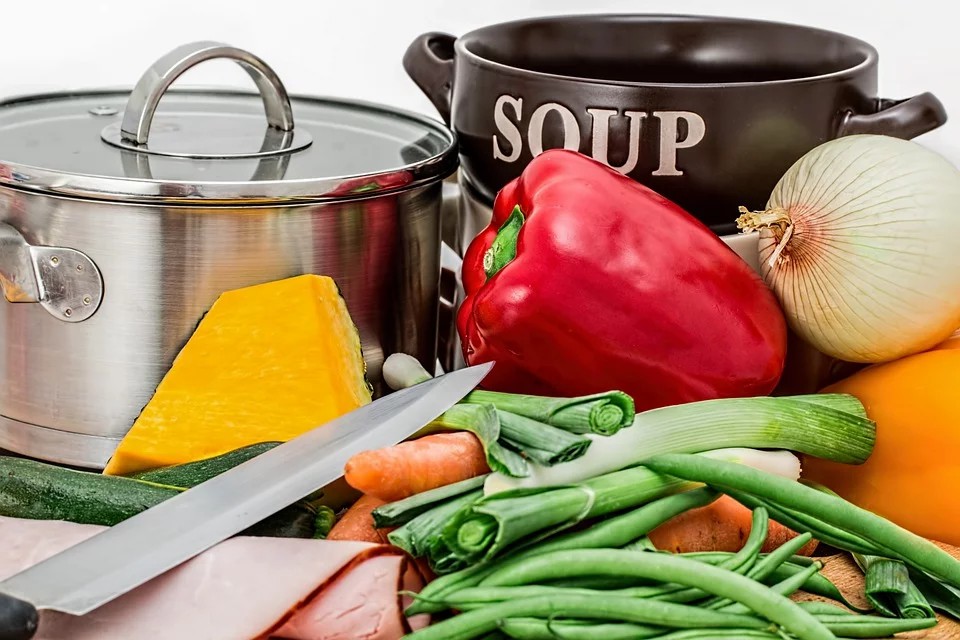
Overview:
Here’s another great one for the vegans. If you’ve never tried vegetable broth before, you may be surprised at just how rich and flavorsome it can be. It may not be as meaty as chicken broth, but it still makes a great substitute that works for most chicken broth dishes.
Advantages:
There are some vegetable broths containing meat or dairy on the market, but many are geared towards vegetarians and vegans. This makes it a great, accessible option if you’re cutting meat and/or dairy out of your diet.
Although it usually contains no meat and therefore doesn’t have as much of a “meaty” flavor as chicken broth, it is usually just as rich and flavorsome in other ways. Vegetable broth is available in a variety of flavors and forms, including liquid and powder forms, so the flavor possibilities are endless.
There are also many low-salt vegetable broth varieties out there, making it a good option if you’re health conscious – just make sure you read the label to ensure that it meets your needs.
Disadvantages:
The most obvious disadvantage here is that vegetable broth and chicken broth don’t taste quite the same. If you’re specifically going for a meaty flavor, then you may find it difficult to achieve the same effect. However, if you already have chicken/chicken flavoring in your recipe or don’t mind the difference in flavor, then this won’t be a problem.
Vegetable broth isn’t always vegetarian or vegan, so you may need to do a bit of searching to find one that meets your specific needs. However, vegan vegetable broth is widely available in the USA, the UK and many other countries, and you can always buy online as a last resort.
Vegetable broth may not contain as much protein as meat-based broths (though it is also typically lower in salt and fat). This isn’t much of a disadvantage, but it’s worth taking into account. Despite being derived from vegetables, it also doesn’t contain a very high amount of vitamins or minerals.
Nutritional Breakdown:
Vegetable broth |
Amount (per 100 g) |
% Recommended daily intake |
Calories |
5 kcal |
14 % |
Total fat |
- |
0 % |
Saturated fat |
- |
0 % |
Cholesterol |
- |
0 % |
Salt |
400 mg |
16 % |
Protein |
- |
0 % |
Total carbohydrates |
1.3 g |
0 % |
Calcium |
- |
0 % |
Iron |
- |
0 % |
Potassium |
- |
0 % |
Vitamin A |
289 IU |
4 % |
4. Water and bouillon cubes 🥩 / 🌱
Best for: most chicken broth dishes

Overview:
Tired of messing around with liquid and powdered broths? Then why not give bouillon cubes a try? Bouillon cubes have all the flavor and richness of chicken broth in the convenience of a cube. To use, simply add one (or more) cubes to the amount of water specified on the box, dissolve, and add to your recipe.
Advantages:
While opened liquid chicken broth lasts only a few days in the fridge, bouillon cubes can last up to 2 years with proper storage. They can also be used many more times than liquid chicken broth per pack, because they are concentrated and made to be dissolved in water. This makes bouillon cubes a much more convenient option if you’re planning on using broth in your future dishes. Although powder also lasts a long time in the cupboard, the advantage of using cubes is that it’s super easy to figure out how much to use: if you’re making one serving, use one cube, etc.
And this great level of convenience does not come at the cost of flavor. Chicken bouillon cubes can taste just as good as the real thing, and if you’re vegetarian or vegan, there are plenty of vegetable bouillon cubes available too.
The nutritional content of bouillon cubes is usually around the same as that of other varieties of broth powders, so you’re not losing out here. If you go for a meat-based option, you’ll usually get a good amount of protein, and you’ll get around the same amounts of vitamins and minerals as you would with other forms of meat or vegetable broths.
Disadvantages:
However, like other forms of broth, bouillon cubes are usually very high in salt. Make sure you check the label so that you’re aware of just how much it contains, especially if you have a health condition that can be negatively affected by a high salt intake. Bouillon cubes can also be quite high in fat and saturated fat, but this isn’t much of a problem if you’re only using one or two cubes.
Bouillon cubes are not quite as widely available as powdered broth or stock varieties. They are usually pretty easy to find in the USA, but can be more of a challenge in the UK and other countries. However, you can always buy online if you can’t find any in stores near you.
Nutritional breakdown:
Vegetable bouillon cubes |
Amount (per 100 g) |
% Recommended daily intake |
Calories |
360 kcal |
16 % |
Total fat |
36 g |
55 % |
Saturated fat |
18 g |
90 % |
Cholesterol |
- |
0 % |
Salt |
18,540 mg |
773 % |
Protein |
18 g |
34 % |
Total carbohydrates |
- |
0 % |
5. Water and butter / olive oil 🥩 / 🌱
Best for: dishes in which you want the flavors of other ingredients to shine through
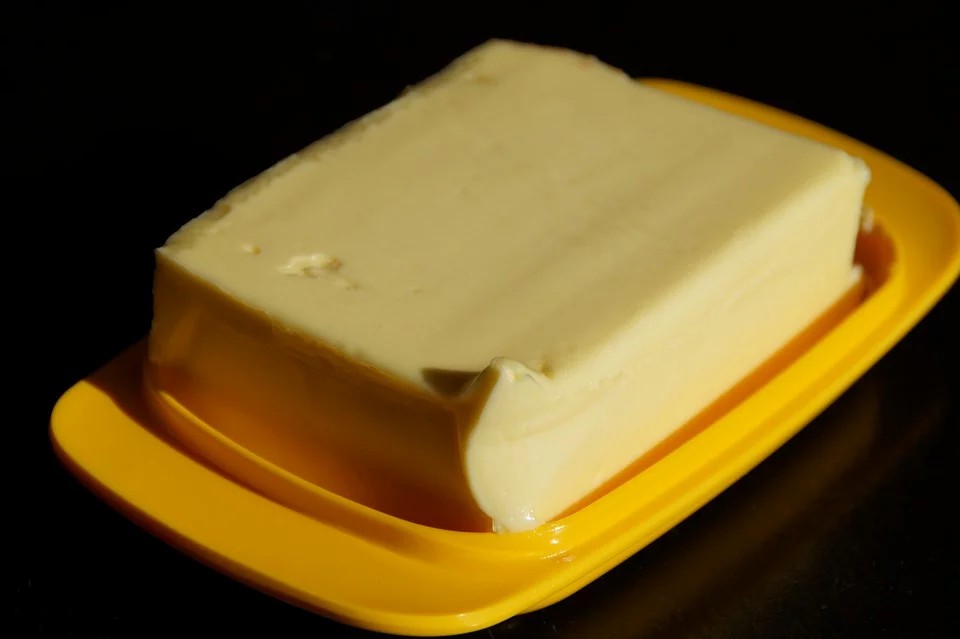
Overview:
If you’re short on time and don’t have any other options at hand, a simple mixture of water and butter or olive oil can make a surprisingly good alternative to the real stuff. To make, add a tablespoon of butter or 2 tablespoons of olive oil to one cup of water.
Advantages:
The best thing about this alternative is just how convenient it is. The vast majority of us will always have a tub of butter or bottle of olive oil at hand, and water is the most widely available ingredient of them all. It’s also super quick and easy to make; simply add 1 tablespoon of butter or 2 tablespoons of olive oil to 1 cup of water, mix well, and add to your recipe and substitute exactly (a 1:1 substitution ratio) for the amount of chicken broth called for.
While this substitute isn’t as flavorful as the real thing, the fat from the butter or olive oil adds a slightly creamy richness that effectively mimics the richness of chicken broth. Some cooks even prefer to leave out the broth in certain recipes so that the other flavors in the dish can come through more fully. This largely depends on your specific recipe and the other ingredients you’re using, but it’s not always a bad thing to have a less distinctively flavored broth alternative.
A tablespoon of butter obviously isn’t the healthiest thing in the world, but it also doesn’t have the scarily high salt content that a lot of chicken broth varieties have. Olive oil has significantly less saturated fat than butter, making it a better option if you want to minimize your intake of “bad fats”.
This substitute works equally well for vegans and non-vegans alike, as vegan butter or olive oil can easily be subbed in for non-vegan butter and work just as well.
Disadvantages:
This probably isn’t the substitute for you if you’re looking to gain a strong, distinctive flavor from your broth. Although this option can work very well if you want the flavors of the other ingredients in your dish to take center stage, it doesn’t provide a whole lot of flavor itself.
Though butter is low on salt, it contains around 18% of your daily recommended total fat and 35% of your daily recommended saturated fat in just 1 tablespoon. You may therefore want to consider other options if you’re on a low-fat diet.
Nutritional breakdown:
Water and butter |
Amount (per 100 g) |
% Recommended daily intake |
Calories |
57 kcal |
3 % |
Total fat |
6 g |
9 % |
Saturated fat |
4 g |
20 % |
Cholesterol |
17.2 mg |
5 % |
Salt |
0.9 mg |
0 % |
Protein |
0.1 g |
0 % |
Total carbohydrates |
- |
0 % |
Calcium |
- |
0 % |
Iron |
- |
0 % |
Potassium |
1.9 mg |
0 % |
Vitamin B-6 |
- |
0 % |
6. Wine (white or red) 🌱
Best for: most chicken broth dishes, as long as you don’t mind the winey kick coming through

Overview:
Who said broth substitutes can’t be fun? Okay, so wine will never really taste like chicken or other broth varieties, but it still adds a rich flavor that can really bring out the other flavors in your dish. White wine typically works best as a substitute for chicken broth, but red wine can also be used if you’re looking for a bolder. flavor. To use, substitute every 1 cup of chicken broth called for by your recipe for 1/2 a cup of wine and 1/2 a cup of water. You can always alter these ratios if you want a weaker or stronger wine flavor coming through in your dish.
Advantages:
If you already have a bottle of white or red wine stashed away in your cupboard, this can make a convenient substitute that doesn’t require you to go off to the store. Even if you don’t have any at hand, wine is a widely available ingredient that comes in a variety of types and flavors, allowing you to pick out whichever best suits your tastes. It is also flexible in the sense that you can sub in more or less water depending on how strongly you want the wine’s flavor to come through.
Alcohol is never going to be the healthiest ingredient, but unlike chicken broth, wine does not come with the problem of a staggeringly high salt content. In fact, wine usually contains almost no salt at all. It also contains small amount of some vitamins and minerals such as vitamin B-6 and high amounts of antioxidants, so consuming small volumes can be considered beneficial to your health.
The vast majority of wine is absolutely fine for vegans to consume, making it a viable option if you’re looking for a vegan alternative.
Disadvantages:
Wine will obviously not have the same meaty flavor as chicken broth. Whether or not this is a negative for you all depends on your dish and the other ingredients in it. If you already have other chicken flavored ingredients (or chicken itself) in your dish or don’t mind a less meaty flavor, this could still be a good option for you.
This probably isn’t the best option if you’re trying to cut back on alcohol and the negative health effects that come along with it. However, as long as you don’t go overboard on how much you include in your dish, this substitute won’t cause any adverse effects (except maybe making you a little tipsy!).
Nutritional breakdown:
White wine |
Amount (per 100 g) |
% Recommended daily intake |
Calories |
82 kcal |
4 % |
Total fat |
- |
0 % |
Saturated fat |
- |
0 % |
Cholesterol |
- |
4 % |
Salt |
5 mg |
0 % |
Protein |
0.1 g |
0 % |
Total carbohydrates |
2.6 g |
0 % |
Calcium |
- |
0 % |
Iron |
0.27 mg |
1 % |
Potassium |
71 mg |
2 % |
Magnesium |
10 mg |
2 % |
Vitamin B-6 |
0.1 mg |
5 % |
(Based on USDA nutritional information on white wine.)
7. Dashi 🥩 / 🌱
Best for: dishes with fish or seafood ingredients
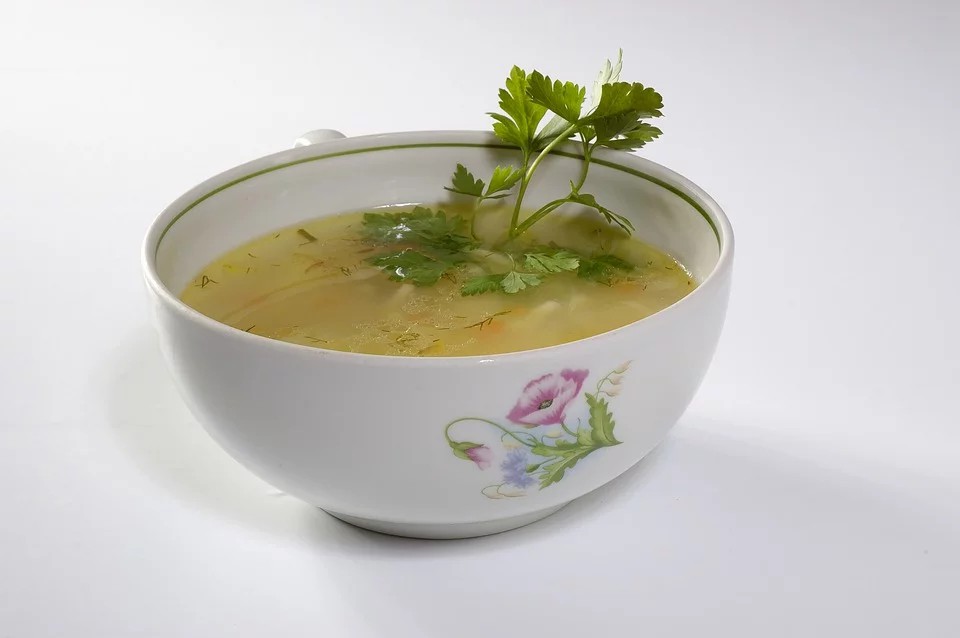
Overview:
Dashi is a Japanese favorite that can be described as fish stock or broth. It is typically made from kombu (edible kelp), katsuobushi (dried, fermented, smoked skipjack tuna) and water. As you could imagine, this does produce a fishier flavor than chicken broth would, but it can be a good choice if you’re going for a seafood feel or you feel like experimenting with new flavors.
Advantages:
Although there is a distinct difference in the flavors of chicken broth and dashi, dashi is still essentially a type of broth and has similar levels of richness to its flavor. The fishier flavor of dashi won’t work well in all dishes, but if your recipe also contains other seafood ingredients, this could be a great option to complement those flavors.
Like chicken broth, dashi comes in a variety of forms, from pre-made liquid dashi to powdered varieties. There are also various online recipes you can look into if you’d prefer to make your own.
Dashi is also nutritionally similar to chicken broth. It contains a good amount of protein, calcium and potassium as well as smaller amounts of other vitamins and minerals.
Disadvantages:
The flavor of dashi is distinctly different from the flavor of chicken broth. This will create a noticeably different end-result in most dishes if you’re using a 1:1 substitution ratio. Like we said, this isn’t necessarily a bad thing if you’re cooking with other seafood ingredients or the flavor combination would work well. But if you don’t want the fishier flavor to come through as much, you can always add less dashi and more water to help dilute the flavor.
Unfortunately, dashi’s nutritional similarity to chicken broth isn’t a purely positive thing. Like chicken broth, dashi often contains incredibly high amounts of salt and moderate amounts of fat and saturated fat. If you’re watching your salt intake, make sure to look for varieties with a lower salt content.
Dashi usually isn’t vegan or vegetarian, as it contains fish. There are varieties made only with kombu (edible kelp) and no fish, but they can be tricky to find, especially in the West.
Speaking of which, even more traditional forms of dashi can be difficult to find in the West. If you can’t find any in the international aisle of your local grocery store, you may be better off looking for options online.
Nutritional breakdown:
Dashi granules |
Amount (per 100 g) |
% Recommended daily intake |
Calories |
265 kcal |
13 % |
Total fat |
14 g |
22 % |
Saturated fat |
3.5 g |
18 % |
Cholesterol |
13 mg |
4 % |
Salt |
23,900 mg |
996 % |
Protein |
16.5 g |
33 % |
Total carbohydrates |
18 g |
6 % |
Calcium |
150 mg |
15 % |
Iron |
1 mg |
6 % |
Potassium |
310 mg |
9 % |
8. Water 🌱
Best for: dishes in which you want the flavors of other ingredients to shine through

Overview:
Yep, just water. Plain and simple. This isn’t the most exciting substitute on the list, but it’s surprisingly good for a “last resort”. Using water in place of chicken broth can even help to enhance the flavor of your dish in some instances. To use in your recipe, simply replace every 1 cup of chicken broth for 1 cup of water (a 1:1 substitution ratio).
Advantages:
You may be surprised to hear that using plain old water in place can actually improve the overall flavor of your dish. In certain recipes, the richness and strong flavors of chicken broth can overpower the flavors from the other ingredients in the dish. If you have other flavors in your dish that you really want to take the spotlight, using water in place of broth will help you do that.
The other great thing about water? It’s so much cheaper and more convenient. Why rely on having broth powder in your cupboard when you can simply turn on the tap whenever you wish?
And yet another thing you don’t have to worry about with water is the health drawbacks. Of course, it doesn’t really have any health benefits of its own (except being great for hydration!) but it is also completely free of calories, salt, fat – you name it. The total lack of salt in water is especially beneficial when compared against the staggeringly high salt content of most chicken broths.
Disadvantages:
Naturally this isn’t a great option if you’re relying on the chicken broth to add that extra touch of flavor to your dish. Water will not provide any extra flavor, so you’ll be relying purely on the other ingredients in your dish to create your desired flavor. If you don’t think this will work for your recipe, you’ll probably want to try a more flavorful substitute.
Nutritional breakdown:
Nothing to see here! Water is always important for hydration, but free from calories and nutrients.The Bottom Line
We hope that after reading our list of substitutes, you feel equipped with a range of great chicken broth alternatives for a variety of occasions. But if you’re still a little confused, not to worry. Let’s end on a quick roundup of our top picks for vegans, health, convenience and similarity to chicken broth.
Top vegan picks
You’ll be happy to see that most of the substitutes on our list actually have vegan options available. Vegetable broth, bouillon cubes, water and butter / olive oil, wine and (of course) water all come in vegan forms that usually aren’t too hard to come by.
Top healthy picks
The main health concern that comes with chicken broth is its high salt content. If this is your main reason for substituting, you can either go with lower salt varieties of chicken broth, beef broth, vegetable broth, dashi or bouillon cubes, or really cut the salt content down and go for wine, water and butter / olive oil or plain water.
Top convenient picks
The clear winner in terms of convenience is plain ol’ water. Water is super accessible at all times and is completely free, making it a perfect option if you’re in a pinch or don’t fancy trekking off to the store. But if you want an alternative with a little more flavor or substance, water and butter or powdered broth forms (such as bouillon cubes) also make convenient substitutes.
